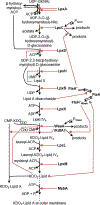Design patterns of biological cells
- PMID: 38247191
- PMCID: PMC10922931
- DOI: 10.1002/bies.202300188
Design patterns of biological cells
Abstract
Design patterns are generalized solutions to frequently recurring problems. They were initially developed by architects and computer scientists to create a higher level of abstraction for their designs. Here, we extend these concepts to cell biology to lend a new perspective on the evolved designs of cells' underlying reaction networks. We present a catalog of 21 design patterns divided into three categories: creational patterns describe processes that build the cell, structural patterns describe the layouts of reaction networks, and behavioral patterns describe reaction network function. Applying this pattern language to the E. coli central metabolic reaction network, the yeast pheromone response signaling network, and other examples lends new insights into these systems.
Keywords: cell biology modeling; cell signaling; metabolism; systems biology.
© 2024 The Authors. BioEssays published by Wiley Periodicals LLC.
Figures













Update of
-
Design Patterns of Biological Cells.ArXiv [Preprint]. 2023 Oct 11:arXiv:2310.07880v1. ArXiv. 2023. Update in: Bioessays. 2024 Mar;46(3):e2300188. doi: 10.1002/bies.202300188. PMID: 37873010 Free PMC article. Updated. Preprint.
References
-
- Alexander C: The pattern of streets. Journal of the American Institute of Planners 32(5), 273–278 (1966)
-
- Alexander C, Ishikawa S, Silverstein M, Jacobson M, Fiksdahl-King I, Angel S: A Pattern Language: Towns, Buildings, Construction. Oxford university press, New York: (1977)
-
- Alexander C: The Timeless Way of Building. Oxford university press, New York: (1979)
-
- Gamma E, Johnson R, Helm R, Johnson RE, Vlissides J: Design Patterns: Elements of Reusable Object-oriented Software. Addison-Wesley, New York: (1995)
-
- McAdams HH, Shapiro L: Circuit simulation of genetic networks. Science 269(5224), 650–656 (1995) - PubMed
Publication types
MeSH terms
Grants and funding
LinkOut - more resources
Full Text Sources

